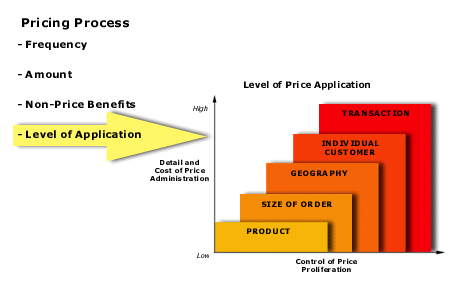BASIC STRATEGY GUIDE: STEP 22
Activity Three: Develop a pricing policy to improve the Company’s market share and returns.
Step 22: Change the pricing process according to the direction of industry prices.

What:
Change the Company’s pricing process to take advantage of the forecast change in industry prices. This process includes the determination of: the frequency of price movement, the amount of price movement, the potential for non-price benefits for the Company and the level at which the Company sets its price. The Company has the greatest control over the level at which it sets its price.
Why:
There is a trade off between the control of pricing and the cost to administer the pricing policy. The more resources the Company devotes to pricing, the more expensive will be its cost of administering the pricing program. However, this high level of resources allows the Company to limit any price decline to a smaller segment of the market. In a rising price environment, the Company improves it margins by reducing resources devoted to pricing in order to minimize the cost of administering its pricing program.
What to Watch For:
-
The frequency and amounts of price movements may be largely out of the Company’s hands. The exception occurs when the industry’s capacity changes quickly relative to demand.
-
The frequency of price changes increases when industry prices are either rising during a Reprieve market or falling in a Deteriorating market or Hostile market.

-
The industry will usually see prices falling in larger amounts during Deteriorating markets and rising by smaller amounts in Reprieve markets.
-
The Company may have opportunities with larger customers to improve its profits by realizing direct savings in logistics and more revenues with better product mix with no cost to the customer. These non-price benefits are effective price adjustments hidden from competition.
-
The company might seek to get a better cost of serving the customer
-
The Company might seek to sell the customer more of its high-end product purchase
-
-
The Company might improve its economies of scale by seeking a greater share of the relationships of those customers it serves well.
-
As markets become Hostile, pricing moves from product-based to a customer-based level. As the level of price application changes, so too must change the profit and loss reporting of the company. Once customers begin receiving discounts that vary by product, product profitability begins to be less meaningful than customer profitability. Virtually all Hostile markets must measure profitability at the individual customer level.

-
The rise in the cost of administration as the Company increases the detail at which it sets its pricing should be part of the Company’s economies of scale. The bigger the company, compared to its competitors, the lower the cost this administration of pricing should be compared to theirs. This should be another aspect of advantage in a Hostile market place.
-
The closer to its list prices a company sells its products, the more it would wish to have a simple pricing structure, one that is very inexpensive to administer.
Action:
Increase the resources devoted to pricing as industry prices or margins decline and reduce them as industry margins or prices rise.
More Information on the Pricing Process on the Advanced Site >>
For helpful context on this step:
Videos:
Perspectives:
Symptoms and Implications:
